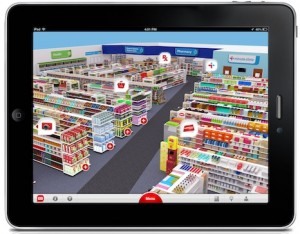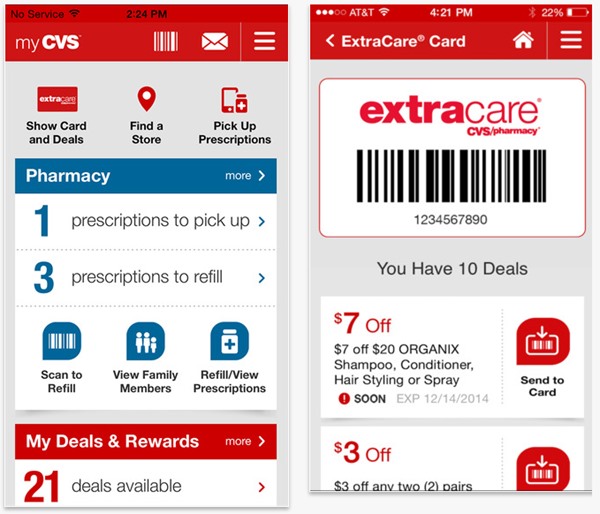Tracking The Evolution Of CVS Caremark’s Mobile Successes
CVS Caremark lives up to its branding – it markedly cares about its customers. It must do, for it boasts the biggest loyalty program in the US – and if one thing’s for certain, customers aren’t loyal to brands and retailers that are indifferent to their evolving needs.
Indeed, it is in this very notion that CVS has proven itself as a worthy retailer, consistently ready to advance its technologies for the ultimate benefit of the customer. And nowhere is this more apparent than in its mobile apps, which, over the past few years, have developed into something that has truly revolutionized how consumers manage their drugstore needs.
Let’s take a closer look at the evolution of CVS mobile customer solutions.
Tracking The Mobile Success Of CVS
2012 – The first app
CVS launched its first mobile app way back in 2012, and the response was almost immediately overwhelming. Originally an extension of its ecommerce activities, between 2012 and 2013 traffic on the CVS mobile site and app increased 250% as consumers increasingly embraced digital. It was clear to the company that the future of retail growth lay somewhere within the digital world.
2013 - Experimentation
Experimentation was key for Brian Tilzer, CVS’s Chief Digital Officer, as he explained in MobiHealthNews.com in 2013, following the launch of CVS’s iPad app – an application that generates a 3D version of the CVS store right on the user’s tablet. Indeed, what makes the CVS mobile evolution story so inspiring is that much of the technology that is in use in 2016 has been built using real data from earlier trials by the retailer. CVS doesn’t assume anything – it puts its ideas to customers and listens to what they say.

"The culture of digital experimentation is something we're taking very seriously," said Tilzer. "It's not a normal app, it's not a list of products. What we have is a digital rendering of a store. It's not that we know this is the best way to interact with customers. We want to find out.
"The reason this is so critical is that the world is changing," he continued."If you look at the pressures to manage costs, consumers want to play a bigger role in healthcare, and they're going to need to in the future. We see digital as a tool to begin addressing these challenges, but it's going to require us to think differently about digital."
2014 – The Digital Toolkit
Tilzer was right. In 2014, a series of job postings went up on LinkedIn as CVS looked to expand its IT team. The posts looked like they could be adverts for roles at an exciting new digital start-up, rather than an established and thriving retail chain with more than 7,800 stores across the country:
"As part of our CVS Caremark Digital Team you will impact our strategy of creating a seamless user experience across various platforms including web and mobile.The new positions will focus on SEO, e-commerce, Service Oriented Architecture and UI/UX design.”
One of the great innovations that came out of this period was the CVS “digital toolkit”. As consumers increasingly embraced the smartphone revolution, CVS stepped up by improving its apps to bring added convenience to customer wellness goals by simplifying prescription refills and sending reminders for when to take prescribed medications. Indeed, CVS’s mission was to position itself to play an important role in enabling its customers to reach their goals – and that’s exactly what the digital toolkit did.
As Tilzer explained to Mobile Commerce Daily in 2014:
“CVS Caremark has been at the forefront of mobile innovation, and one of the biggest ‘wins’ from a customer experience perspective is what we’re calling our digital toolkit. Our numerous health resources allow us to put customers’ health at the forefront.
“The CVS/pharmacy Mobile smartphone app includes features like the “Pill Identifier”and “Drug Interaction Checker”, and CVS/pharmacy has even developed a voice-activated pharmacy in the CVS/pharmacy iPad app that makes it easier than ever before for customers to use their phone or iPad to manage and refill prescriptions, as well as keep track of their family’s medicines and health.”
2015 – Economy and Efficiency
By 2015, CVS was hard at work creating a long series of updates to its mobile apps and strategies – and it’s really no surprise that the resulting revisions put the consumer’s convenience first in ways that had never been possible, or even thought of,before.

A large focus with the new digital tools released last November went into providing greater efficiency and economy for CVS’s customers and their healthcare needs. According to research conducted by the CVS Health Research Institute, pharmacy customers enrolled in digital and online programs demonstrate better medication adherence and reduced health care costs overall – illustrating the potential impact of new the CVS Health digital tools.
William H. Shrank, M.D., M.S.H.S, Senior Vice President and Chief Scientific Officer for CVS Health, explains on the company’s website:
"Our research shows that digital and online tools help make adherence easier and more accessible for our customers across the enterprise, and evidence suggests that better adherence improves patient health outcomes while reducing health care costs."
Specifically, the research found that 10% more CVS members improved their medication adherence to optimal levels after enrolling with CVS’s digital services compared to those that didn’t enroll. Furthermore, the study revealed that digital subscribers to CVS could save up to $2.3 million in medical cost avoidance a year per 100,000 registered users.
2016 – The toolkit expands
In 2016, the CVS digital toolkit has a very clear objective – to ensure that its users are provided with the greatest ease and convenience possible, as well as enabling patients to manage their health with an accuracy and reliability that only the combination of data and technology can provide.
There is now an Apple Watch app integration for the CVS/Pharmacy mobile app, which notifies customers when prescriptions are ready, enables them to check information at a glance, reminds them to take their medication, and users can even order refills right from their wrist.
There is also the Scan Paper Script tool, which enables customers to quickly and conveniently start the prescription fill process by capturing a photo of their written prescription through the CVS/Caremark mobile app.

Med Remind is a feature which is deployed on the CVS/Pharmacy iPhone mobile app. The main purpose of this is to combat forgetfulness, which is the main cause for non-adherence to medication plans. Users can customize reminders either on their phones or Apple Watch, and notifications are sent to caregivers if a dose is missed.
Then there’s the Insurance Card Scan feature, which makes sharing new insurance information with the pharmacist as easy as taking a photo of the patient’s insurance card – the app will then instantly update the data right across the CVS store system.Indeed, this even lightens the admin load for pharmacists, who can now dedicate more time to direct patient care.
In-store Pharmacy Messaging is another feature that uses beacons, which send customers push notifications when they’re in a store, alerting them if their prescription is ready for refill or to pick up.
The Future – Beyond Convenience
The digital and mobile successes of CVS are far from over. Indeed, for Tilzer, they’ve only just begun.
What’s important to note from the evolutionary journey of CVS is that the retailer always places emphasis on the customer’s needs first. This, indeed, is exactly why CVS has such a strong loyalty base, and why it will continue to have one in the future.
In fact, the future for CVS customers look to be filled with even more technology solutions that are all conceived to help them better manage their healthcare.
Let’s leave it to Brian Tilzer, speaking in an interview with HIT Consultant in February this year, one last time to tell us what we’ve got to look forward to:
“Because we serve more than 5 million customers every day, we have a huge opportunity to use technology to improve the health outcomes of our customer, by extending our services to meet them anytime, anywhere. For us, the benefits of technology aren’t just driving people back to our platforms: it’s about uncovering the most effective ways to help all people on their path to better health. Our vision is to create a ‘connected’ health experience that makes it radically easier for people to save time and money—and stay healthy. Imagine being able to easily refill your prescriptions from your couch. To check how medicines interact with each other. Or – not too far in the future – being able to actually diagnose your child’s sore throat in the kitchen on a Saturday night, while interacting with a doctor over your device – instead of having to wait until Monday morning to bring them into the doctor’s office. There are many possible touch points throughout the customer journey. We identify these challenges as moments to engage our customers and enhance their connected health experience, both online and offline.”
Make sure to also download the eTail agenda to discover all of the great activities, speakers, & sessions planned for this year.
Download the latest eTail agenda

About John Waldron: John Waldron is a technology and business writer for markITwrite digital content agency, based in Cornwall, UK. He writes regularly across all aspects of marketing and tech, including SEO, social media, FinTech, IoT, apps and software development.